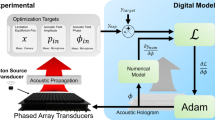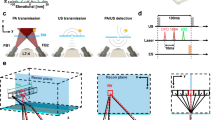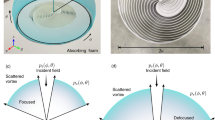Abstract
For classical waves such as light or sound, diffraction sets a natural limit on how finely the details of an object can be recorded on its image. Recently, various optical superlenses based on the metamaterials concept have shown the possibility of overcoming the diffraction limit1,2,3,4,5,6,7. Similar two-dimensional (2D) acoustic hyperlens designs have also been explored8,9,10. Here we demonstrate a 3D holey-structured metamaterial that achieves acoustic imaging down to a feature size of λ/50. The evanescent field components of a subwavelength object are efficiently transmitted through the structure as a result of their strong coupling with Fabry–Pérot resonances inside the holey plate. This capability of acoustic imaging at a very deep-subwavelength scale may open the door for a broad range of applications, including medical ultrasonography, underwater sonar and ultrasonic non-destructive evaluation.
This is a preview of subscription content, access via your institution
Access options
Subscribe to this journal
Receive 12 print issues and online access
$259.00 per year
only $21.58 per issue
Buy this article
- Purchase on SpringerLink
- Instant access to full article PDF
Prices may be subject to local taxes which are calculated during checkout




Similar content being viewed by others
References
Pendry, J. B. Negative refraction makes a perfect lens. Phys. Rev. Lett. 85, 3966–3969 (2000).
Smith, D. R., Pendry, J. B. & Wiltshire, M. C. K. Metamaterials and negative refractive index. Science 305, 788–792 (2004).
Soukoulis, C. M., Linden, S. & Wegener, M. Negative refractive index at optical wavelengths. Science 315, 47–49 (2007).
Fang, N., Lee, H., Sun, C. & Zhang, X. Sub-diffraction-limited optical imaging with a silver superlens. Science 308, 534–537 (2005).
Taubner, T., Korobkin, D., Urzhumov, Y., Shvets, G. & Hillenbrand, R. Near-field microscopy through a SiC superlens. Science 313, 1595 (2006).
Liu, Z., Lee, H., Xiong, Y., Sun, C. & Zhang, X. Far-field optical hyperlens magnifying sub-diffraction-limited objects. Science 315, 1686 (2007).
Liu, Z. et al. Far-field optical superlens. Nano Lett. 7, 403–408 (2007).
Guenneau, S., Movchan, A., Pétursson, G. & Ramakrishna, S. A. Acoustic meta-materials for sound focussing and confinement. New J. Phys. 9, 1367–2630 (2007).
Ao, X. & Chan, C. T. Far-field image magnification for acoustic waves using anisotropic acoustic metamaterials. Phys. Rev. E 77, 025601(R) (2008).
Li, J., Fok, L., Yin, X., Bartal, G. & Zhang, X. Experimental demonstration of an acoustic magnifying hyperlens. Nature Mater. 8, 931–934 (2009).
Pendry, J. B., Holden, A. J., Robbins, D. J. & Stewart, W. J. Magnetism from conductors and enhanced nonlinear phenomena. IEEE Trans. Microw. Theory Tech. 47, 2075–2084 (1999).
Smith, D. R., Padilla, W. J., Vier, D. C., Nemat-Nasser, S. C. & Schultz, S. Composite medium with simultaneously negative permeability and permittivity. Phys. Rev. Lett. 84, 4184–4187 (2000).
Shalaev, V. M. Optical negative-index metamaterials. Nature Photon. 1, 41–48 (2006).
Liu, Z. et al. Locally resonant sonic materials. Science 289, 1734–1736 (2000).
Fang, N. et al. Ultrasonic metamaterials with negative modulus. Nature Mater. 5, 452–456 (2006).
Zhang, S., Yin, L. & Fang, N. Focusing ultrasound with an acoustic metamaterial network. Phys. Rev. Lett. 102, 194301 (2009).
de Rosny, J. & Fink, M. Overcoming the diffraction limit in wave physics using a time-reversal mirror and a novel acoustic sink. Phys. Rev. Lett. 89, 124301 (2002).
Lerosey, G., de Rosny, J., Tourin, A. & Fink, M. Focusing beyond the diffraction limit with far-field time reversal. Science 315, 1120–1122 (2007).
Yang, S. et al. Focusing of sound in a 3D phononic crystal. Phys. Rev. Lett. 93, 024301 (2004).
Zhang, X. D. & Liu, Z. Y. Negative refraction of acoustic waves in two-dimensional phononic crystals. Appl. Phys. Lett. 85, 341–343 (2004).
Sukhovich, A., Jing, L. & Page, J. H. Negative refraction and focusing of ultrasound in two-dimensional phononic crystals. Phys. Rev. B 77, 014301 (2008).
Sukhovich, A. et al. Experimental and theoretical evidence for subwavelength imaging in phononic crystals. Phys. Rev. Lett. 102, 154301 (2009).
He, Z., Cai, F., Ding, Y. & Liu, Z. Subwavelength imaging of acoustic waves by a canalization mechanism in a two-dimensional phononic crystal. Appl. Phys. Lett. 93, 233503 (2008).
Cervera, F. et al. Refractive acoustic devices for airborne sound. Phys. Rev. Lett. 88, 023902 (2002).
Yang, S. et al. Focusing of sound in a 3D phononic crystal. Phys. Rev. Lett. 93, 024301 (2004).
Ke, M. et al. Flat superlens by using negative refraction in two-dimensional phononic crystals. Solid State Commun. 142, 177–180 (2007).
Jung, J., Garcia-Vidal, F. J., Martin-Moreno, L. & Pendry, J. B. Holey metal films make perfect endoscopes. Phys. Rev. B 79, 153407 (2009).
Belov, P. A., Simovski, C. R. & Ikonen, P. Canalization of subwavelength images by electromagnetic crystals. Phys. Rev. B 71, 193105 (2005).
Wiltshire, M. C. K., Hajnal, J., Pendry, J. B., Edwards, D. & Stevens, C. Metamaterial endoscope for magnetic field transfer: Near field imaging with magnetic wires. Opt. Expr. 11, 709–715 (2003).
Belov, P. A. & Silveirinha, M. G. Resolution of subwavelength transmission devices formed by a wire medium. Phys. Rev. E 73, 056607 (2006).
Silveirinha, M. G., Belov, P. A. & Simovski, C. R. Ultimate limit of resolution of subwavelength imaging devices formed by metallic rods. Opt. Lett. 33, 1726–1728 (2008).
Shvets, G., Trendafilov, S., Pendry, J. B. & Sarychev, A. Guiding, focusing, and sensing on the subwavelength scale using metallic wire arrays. Phys. Rev. Lett. 99, 053903 (2007).
Kawata, S., Ono, A. & Verma, P. Subwavelength colour imaging with a metallic nanolens. Nature Photon. 2, 438–442 (2008).
Lu, M. et al. Extraordinary acoustic transmission through a 1D grating with very narrow apertures. Phys. Rev. Lett. 99, 174301 (2007).
Christensen, J., Martin-Moreno, L. & Garcia-Vidal, F. J. Theory of resonant acoustic transmission through subwavelength apertures. Phys. Rev. Lett. 101, 014301 (2008).
Estrada, H. et al. Extraordinary sound screening in perforated plates. Phys. Rev. Lett. 101, 084302 (2008).
Zhou, Y. et al. Acoustic surface evanescent wave and its dominant contribution to extraordinary acoustic transmission and collimation of sound. Phys. Rev. Lett. 104, 164301 (2010).
Acknowledgements
This work has been partially financially supported by the Spanish Ministry of Science under projects MAT2008-06609-C02 and CSD2007-046-Nanolight.es. J.Z. and X.Z. acknowledge support from the US Office of Naval Research (grant number N00014-07-1-0626). We thank M. Nesterov for conducting the finite-element method simulations on wire arrays and holey plates presented in the Supplementary Information.
Author information
Authors and Affiliations
Contributions
F.J.G-V., J.J. and L.M-M. developed the idea of using holey films for deep-subwavelength imaging. J.C. and J.Z. devised the acoustic structure. J.Z., X.Y., L.F. and X.Z. designed and carried out the experiments. J.C. conducted the numerical simulations. J.Z., X.Z., L.M-M. and F.J.G-V. wrote the manuscript and J.C., J.J., X.Y. and L.F. participated in the revisions. F.J.G-V. and X.Z. conceived and led the project.
Corresponding authors
Ethics declarations
Competing interests
The authors declare no competing financial interests.
Supplementary information
Supplementary Information
Supplementary Information (PDF 979 kb)
Rights and permissions
About this article
Cite this article
Zhu, J., Christensen, J., Jung, J. et al. A holey-structured metamaterial for acoustic deep-subwavelength imaging. Nature Phys 7, 52–55 (2011). https://doi.org/10.1038/nphys1804
Received:
Accepted:
Published:
Issue date:
DOI: https://doi.org/10.1038/nphys1804
This article is cited by
-
Visco-thermal Effects on Anisotropic and Isotropic Labyrinthine Acoustic Metamaterials in the Cascade
Journal of Vibration Engineering & Technologies (2024)
-
Refined acoustic holography via nonlocal metasurfaces
Science China Physics, Mechanics & Astronomy (2024)
-
Superwavelength self-healing of spoof surface sonic Airy-Talbot waves
Nature Communications (2023)
-
Far-field ultrasonic imaging using hyperlenses
Scientific Reports (2022)
-
A metasurface composed of orifice-type unit cells for the redirection of acoustic waves
Scientific Reports (2022)



